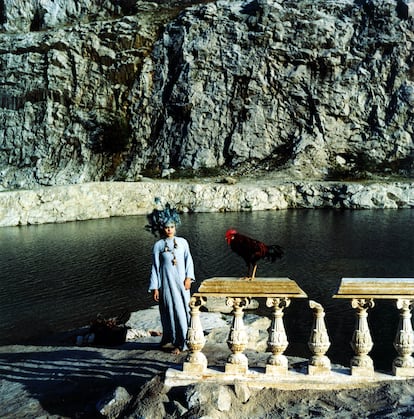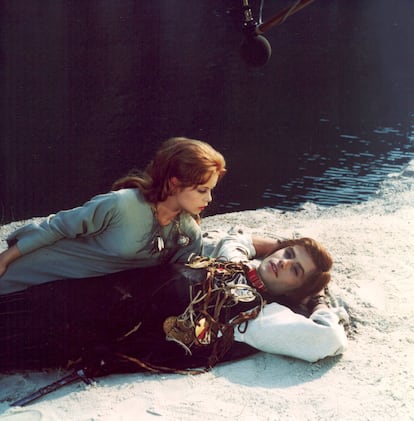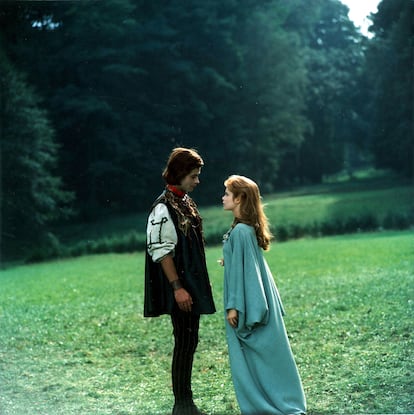‘The Little Mermaid:’ This 1976 psychedelic live-action film could be the best adaptation to date
There have been many versions of Hans Christian Andersen’s classic fairy tale, but the Czech movie ‘Malá mořská víla’ arguably takes top spot because of its social and political commentary

The first film adaptation of Hans Christian Andersen’s classic fairy tale, The Little Mermaid, was a live-action production released in 1952, more than 35 years before Disney created its animated version. One of Hollywood’s most successful directors at the time, Charles Vidor, took the helm of the project, delivering a musical that gives a false account of the author’s inspirations for his most well-known fairy tales, including a sequence which references the story of the mermaid and the prince who couldn’t fall in love with her.
Since then, a great number of films and TV projects have adapted Andersen’s story into live-action or animation, including several Japanese anime television series, a Spanish anthology film, other Hollywood productions, and, of course, the Walt Disney 1989 production, which is now credited for breathing life back into the art of Disney animated feature films and is being re-adapted into live-action. Every version differs from the original story, with some being more light and kid-friendly, and others more mature and dark, with every creator trying to bring it to life with their own style.
Although the Disney version is definitely the most popular, it’s far from being the most interesting adaptation of Andersen’s tale. That honor could easily go to Malá mořská víla, a 1976 live-action Czech film, a creatively brilliant vision of the story that, despite its limitations, manages to tell the story of the young mermaid with fantasy, wonder, and a visual style influenced by surrealism and the Czechoslovak New Wave movement, resulting in one of the strangest but most beautiful versions of The Little Mermaid.

Malá mořská víla
Malá mořská víla (Little Mermaid) was directed by the rebellious director Karel Kachyňa, who was well known for his politically critical movies like Long Live the Republic! and The Ear, in which he developed his style of strange narration with surreal or odd elements within the stories. During the ‘70s, he focused on historical movies, dramas and children’s movies, but his sense of experimentation didn’t stop.
Miroslava Šafránková stars in the film as the Little Mermaid, in a role that was one of her first acting credits. Famous Czech actors like Radovan Lukavský, Petr Svojtka, and Libuše Šafránková appear in supporting roles.
The film presents the underwater world in a unique way. The director uses slow motion and blurring techniques to make the audience feel like they’re underwater, which, aligned with the fantasy setting, gives it a very psychedelic feel throughout. The mermaids are not presented with fish tails but as water spirits. The makeup, costumes, and hairstyles turn every underwater character into a kind of elf or magical creature, while the “real world” looks plain and uninteresting. This strong contrast further separates both worlds.
However, it’s the story and the performances that make this film one of the best versions of Andersen’s work. Although it’s not a completely faithful adaptation, it manages to deliver the light and the dark of the original while inserting new elements that give the story more depth. The story begins with a bright moment: the Little Mermaid plays with her sister before they discover the remnants of a shipwreck in which she finds a drawing of the surface world.

The Little Mermaid is interested in the fate of her mother, who is not part of her life even though mermaids are supposed to live for hundreds of years. She’s also set to be married to a prince, although she’s not convinced by the match; the marriage also involves some political and social conflict between her family and his, adding yet another layer of complexity to a simple fairy tale.
The rest of the film closely resembles other versions. However, Kachyňa’s script (which he penned with children’s literature writer Ota Hofman) introduces the concepts of feminism, social change and revolution, possibly due to his work on his early films and his political influence.
During that time, Czechoslovakia (then a part of the Eastern Bloc of the Soviet Union) experienced a period of relative political stability compared to the preceding years, but it also suffered limitations on civil liberties and political freedoms. The government exercised strict control over the media, promoting mainly communist ideology.
The Soviets censored several of Kachyňa’s scripts, and he was pushed to create other types of films. It’s possible that he used Malá mořská víla to make social and political commentary under the guise of a children’s film.
Either way, Malá mořská víla still stands out as one of the most interesting adaptations of The Little Mermaid with its psychedelic aesthetics, its mixture of beauty and haunting imagery, and its complex script. The good news for those who remain unconvinced by the Disney movie is that Malá mořská víla is available on YouTube.
Sign up for our weekly newsletter to get more English-language news coverage from EL PAÍS USA Edition
Tu suscripción se está usando en otro dispositivo
¿Quieres añadir otro usuario a tu suscripción?
Si continúas leyendo en este dispositivo, no se podrá leer en el otro.
FlechaTu suscripción se está usando en otro dispositivo y solo puedes acceder a EL PAÍS desde un dispositivo a la vez.
Si quieres compartir tu cuenta, cambia tu suscripción a la modalidad Premium, así podrás añadir otro usuario. Cada uno accederá con su propia cuenta de email, lo que os permitirá personalizar vuestra experiencia en EL PAÍS.
¿Tienes una suscripción de empresa? Accede aquí para contratar más cuentas.
En el caso de no saber quién está usando tu cuenta, te recomendamos cambiar tu contraseña aquí.
Si decides continuar compartiendo tu cuenta, este mensaje se mostrará en tu dispositivo y en el de la otra persona que está usando tu cuenta de forma indefinida, afectando a tu experiencia de lectura. Puedes consultar aquí los términos y condiciones de la suscripción digital.
More information
Archived In
Últimas noticias
Alain Aspect, Nobel laureate in physics: ‘Einstein was so smart that he would have had to recognize quantum entanglement’
Imelda Castro, the woman who wants to rule the cartel battleground of Sinaloa
The new victims of the Republican war on Obamacare: Millions hit by soaring health insurance premiums
A country divided on migrant rights: Some US states expand protections while others restrict them
Most viewed
- David King, chemist: ‘There are scientists studying how to cool the planet; nobody should stop these experiments from happening’
- Reinhard Genzel, Nobel laureate in physics: ‘One-minute videos will never give you the truth’
- Oona Chaplin: ‘I told James Cameron that I was living in a treehouse and starting a permaculture project with a friend’
- Sinaloa Cartel war is taking its toll on Los Chapitos
- Mexico completes its trade shift with the entry into force of tariffs on China and countries without trade agreements











































